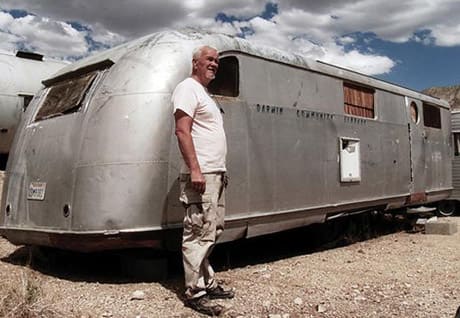The 35 residents of Darwin, CA are an eclectic, antisocial, isolated bunch, which is made boldly apparent by the "No services ahead" sign they erected on the outskirts of town to keep out nosy visitors.
Nestled in the arid, desolate Death Valley, the nearest town and police station are over an hour away, and their closest neighbour is a top secret U.S. naval testing facility. It's incredible that Swiss director Nick Brandestini was able to swoop in with his cameras and invade the townspeople's cherished privacy.
Brandestini's Darwin is predominantly a talking head documentary, interspersed with archival material to showcase the thriving mining town that once was. Formerly an area known for its depravity and unruliness, the current residents are a quiet and largely peaceful group, which is amazing considering that the town exists with no formal government or place of worship.
Shot over the span of two years, we meet characters like Monty (a former miner that shares tales from the town's heyday), as well as Susan, the only employed resident, who operates the post office and is known as the "bitch" of the settlement. Hank and Connie are front and center, slowly opening up about their pagan lifestyle, while Connie's transgendered "son," Ryal, and partner, Penny, struggle with their lifestyle versus location. We're also introduced to an older, self-proclaimed anarchist, a hoarder fearing the apocalypse and a handful of other unique personalities.
Brandestini does an incredible job of listening to the townspeople's stories without apparent manipulation, slowly drawing out tales of criminal pasts, broken families, drugs, guns and misappropriation of welfare and disability cheques. This non-judgemental observation is ultimately what aids the accessibility of the film.
Darwin serves as a time capsule for a way of life that is quickly disappearing in America, romanticizing the Old West yet gently prodding the issue of sustainability. It's interesting to note that Brandestini only interviewed about a third of the townsfolk, all of which can be labelled as "white trash." It begs the question: what stories are the rest of the town hiding from the spotlight?
(Kinosmith)Nestled in the arid, desolate Death Valley, the nearest town and police station are over an hour away, and their closest neighbour is a top secret U.S. naval testing facility. It's incredible that Swiss director Nick Brandestini was able to swoop in with his cameras and invade the townspeople's cherished privacy.
Brandestini's Darwin is predominantly a talking head documentary, interspersed with archival material to showcase the thriving mining town that once was. Formerly an area known for its depravity and unruliness, the current residents are a quiet and largely peaceful group, which is amazing considering that the town exists with no formal government or place of worship.
Shot over the span of two years, we meet characters like Monty (a former miner that shares tales from the town's heyday), as well as Susan, the only employed resident, who operates the post office and is known as the "bitch" of the settlement. Hank and Connie are front and center, slowly opening up about their pagan lifestyle, while Connie's transgendered "son," Ryal, and partner, Penny, struggle with their lifestyle versus location. We're also introduced to an older, self-proclaimed anarchist, a hoarder fearing the apocalypse and a handful of other unique personalities.
Brandestini does an incredible job of listening to the townspeople's stories without apparent manipulation, slowly drawing out tales of criminal pasts, broken families, drugs, guns and misappropriation of welfare and disability cheques. This non-judgemental observation is ultimately what aids the accessibility of the film.
Darwin serves as a time capsule for a way of life that is quickly disappearing in America, romanticizing the Old West yet gently prodding the issue of sustainability. It's interesting to note that Brandestini only interviewed about a third of the townsfolk, all of which can be labelled as "white trash." It begs the question: what stories are the rest of the town hiding from the spotlight?




